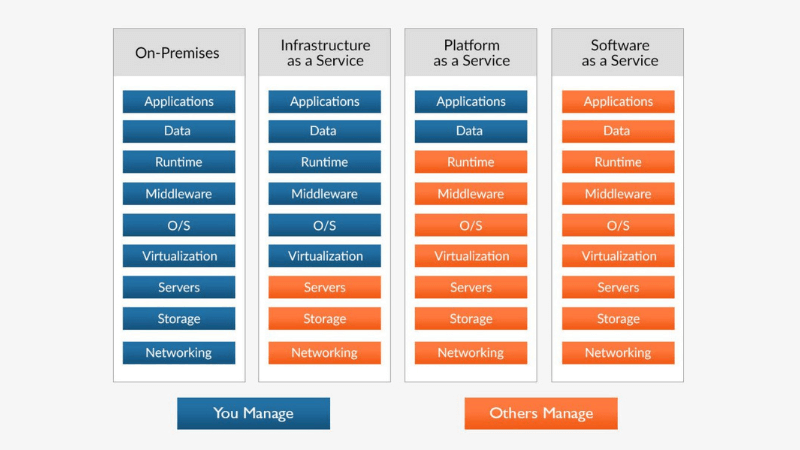Cloud – a hot topic nowadays for both small and big businesses. According to a report by Marketsandmarkets, the global cloud computing market size is expected to grow from USD 445.3 billion in 2021 to USD 947.3 billion by 2026, at a CAGR (Compound Annual Growth Rate) of 16.3% during the forecast period. Also, Multisoft says that 80% of the companies that move to cloud notice improvements in their IT departments in the first six months.
If you consider making the switch to a PaaS or SaaS software, it is important to understand the difference and the advantages of them.
What Are PaaS and SaaS?
PaaS and SaaS are two main types of cloud computing.
Platform as a service (PaaS) is a complete development and deployment environment in the cloud. It has resources that enable you to deliver everything from simple cloud-based apps to complex, cloud-enabled enterprise applications. A third-party provider delivers users hardware and software tools. The resources are purchased on a pay-as-you-go basis from a cloud service provider. All you need to access them is a secure Internet connection. Instead of working on a computer on site, it is possible to log-in from anywhere and collaborate on projects.
With a PaaS, developers don’t need to install in-house hardware and software to develop and run new applications. With PaaS, you don’t need to buy and manage software licenses, middleware, application infrastructure, development tools or other resources. PaaS allows businesses to create and design apps built with special software components. These applications, are scalable and highly available as they take on certain cloud characteristics.
Software as a service (SaaS) is a type of software delivery that allows users to access data from any device that is connected to the internet. Basically, SaaS users use and connect to cloud-based applications on the Internet, which means that they don’t need to download software on their desktop, or run updates. Usually, SaaS subscriptions have a pay-as-you-go model with a recurring fee (monthly or annually).
How Do PaaS and SaaS Work
PaaS works by delivering all development tools in one online interface. PaaS solutions are more suitable for software development purposes. PaaS eliminates the need to work from a specific computer.
A PaaS solution has three main parts:
- a cloud infrastructure that includes virtual machines, storage, firewalls, networking and operating system software;
- a software that helps you build, deploy and maintain apps;
- a graphic user interface where the development team does the work throughout the app’s lifecycle.
PaaS delivers all standard development tools online through the graphic user interface, where the developers can collaborate on projects. This enables streamlined workflows and multiple operations.
SaaS works as an on-demand computing software delivery model. It gives users network access to applications. SaaS is provided on a hosted platform, which means that the administrator doesn’t need to worry about updates, and has no connection to the hardware. Because of this, SaaS reduces the cost and time for deployment, removes some risks of operation, and also reduces the cost of operation.
SaaS can be deployed in three different models:
- private SaaS: the software vendor provides a dedicated private cloud for each customer;
- public SaaS: the software vendor handles upgrades, maintenance, hosting and other actions required by the solution;
- self-managed cloud: it is similar to a private cloud, but your company or a third-party company is taking care of the hosting, monitoring, and upgrades of the software.

Types of PaaS and SaaS
There are three main types of PaaS:
- public PaaS: the customer is not responsible for managing the infrastructure and the platforms run on the public cloud;
- private PaaS: the software helps you develop and deploy on a private infrastructure or behind a firewall;
- hybrid PaaS: the cloud infrastructure consists of two or more distinct cloud infrastructures (public or private) that are bound together by proprietary technology, while remaining unique entities.
There are two types of SaaS:
- horizontal SaaS: it targets a wide audience of business users, no matter which industry they come from;
- vertical SaaS: it is targeted to a particular niche, or industry-specific standards.
Differences Between PaaS and SaaS
The difference between PaaS and SaaS lies in the level of service they provide. PaaS gives you the infrastructure to create your own applications, while they and the data is fully under your control, and SaaS provides you with a total package, including the application itself and the data storage.

This diagram by FinancesOnline shows the differences between PaaS and SaaS.
The Advantages of PaaS and SaaS Platforms
Overall, both PaaS and SaaS come with several advantages for users. Let’s take a look at them:
PaaS:
- reduced costs overall: there is no need to maintain a physical development infrastructure – staff, servers, etc.;
- scalability: PaaS solutions grow with your business and accommodate your needs;
- faster time to market: the PaaS provider will help you start developing immediately;
- flexibility: you develop on the go, and you are not tied to the computer from the office;
- significant reduction in the amount of coding needed;
- affordable access to a great assortment of resources.
SaaS:
- accessibility: users only need an internet browser, which means that they don’t need to worry if their operating system is compatible with the SaaS app they want to use;
- saving and storage: SaaS users do not worry about any possible hardware crash because their information is saved in the cloud. This also means that they don’t need to use the same device all the time to access information;
- multitenant architecture: all users share a common infrastructure and code base, which enables innovation;
- better analytics and data collection: because all data goes through a centralized platform, it is easier to better capture it and to provide more accurate reports. Also, SaaS users have access to reporting tools that provide valuable insights into business operations. This streamlines workflows, which leads to saving some costs;
- savings: there is no need for hardware and data centers;
- scalability: the ever-changing business needs are accommodated perfectly by a SaaS solution that grows simultaneously with the business;
- security: SaaS providers invest a lot in security technology, and users don’t need to worry about pirated software.

Use Cases of PaaS and SaaS
PaaS:
- e-commerce;
- Internet of Things (IoT);
- Agile development;
- DevOps;
- Cloud-native development;
- API development and management;
- Hybrid cloud strategy.
SaaS:
- e-commerce;
- productivity software;
- customer relationship management;
- email;
- marketing automation tools;
- enterprise resource planning;
- project management;
- accounting.
Depending on your business needs, you might want to pursue one or multiple types of cloud services. It is crucial to consider what your future goals are and how you want the solution to enhance your operations. We have prepared an article about Digital transformation and cloud computing that will give you a few details about digital transformation and cloud computing, and their benefits.
